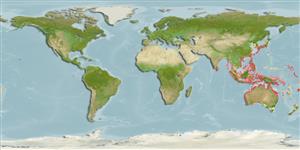Environment: milieu / climate zone / depth range / distribution range
Écologie
marin récifal; profondeur 0 - 10 m (Ref. 93839). Subtropical
Western Pacific: subtropical, from southern Japan to Taiwan, then from subtropical Australia to New Caledonia and the Kermadec Islands.
Taille / Poids / Âge
Maturity: Lm ? range ? - ? cm
Max length : 14.0 cm TL mâle / non sexé; (Ref. 559)
Description synthétique
Clés d'identification | Morphologie | Morphométrie
Épines dorsales (Total) : 8; Rayons mous dorsaux (Total) : 9; Épines anales: 2; Rayons mous anaux: 8. Distinguished by having the following characteristics: dorsal fin rays VII-I, 9; anal fin rays II, 8; pectoral fin rays 15; pelvic fin rays I, 5; pored lateral line scales 24; predorsal scales 3; circumpeduncular scales 12; body pinkish brown, with four dark brown stripes on lateral surface of body; third stripe posteriorly not reaching to a black spot on caudal fin base; caudal fin base spot subequal in size to pupil diameter (Ref. 93839).
Commonly occurs in rocky areas near shore and abundant on ledges. Solitary but pair off during breeding. Mouth brooding is done by the male. Nocturnal species (Ref. 7300).
Mouthbrooders (Ref. 240). Distinct pairing during courtship and spawning (Ref. 205).
Randall, J.E., G.R. Allen and R.C. Steene, 1990. Fishes of the Great Barrier Reef and Coral Sea. University of Hawaii Press, Honolulu, Hawaii. 506 p. (Ref. 2334)
Statut dans la liste rouge de l'IUCN (Ref. 130435)
Menace pour l'homme
Harmless
Utilisations par l'homme
Outils
Articles particuliers
Télécharger en XML
Sources Internet
Estimates based on models
Preferred temperature (Ref.
123201): 20 - 28.9, mean 27.6 °C (based on 1621 cells).
Phylogenetic diversity index (Ref.
82804): PD
50 = 0.5000 [Uniqueness, from 0.5 = low to 2.0 = high].
Bayesian length-weight: a=0.01413 (0.00807 - 0.02472), b=3.17 (3.02 - 3.32), in cm total length, based on LWR estimates for this species & Genus-body shape (Ref.
93245).
Niveau trophique (Ref.
69278): 3.6 ±0.56 se; based on food items.
Generation time: 0.5 ( na - na) years. Estimated as median ln(3)/K based on 1
growth studies.
Résilience (Ref.
120179): Haut, temps minimum de doublement de population inférieur à 15 mois (Preliminary K or Fecundity.).
Fishing Vulnerability (Ref.
59153): Low vulnerability (10 of 100).
Nutrients (Ref.
124155): Calcium = 132 [44, 409] mg/100g; Iron = 1.72 [0.67, 4.15] mg/100g; Protein = 19.5 [17.8, 21.2] %; Omega3 = 0.153 [0.042, 0.558] g/100g; Selenium = 28.6 [6.6, 111.8] μg/100g; VitaminA = 9.24 [1.28, 80.05] μg/100g; Zinc = 1.73 [0.80, 3.44] mg/100g (wet weight);
